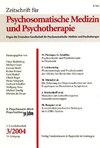Schweigen in der videobasierten Psychotherapie – Eine Pilotstudie.
IF 0.8
4区 医学
Q4 PSYCHIATRY
Zeitschrift Fur Psychosomatische Medizin Und Psychotherapie
Pub Date : 2024-12-01
Epub Date: 2024-10-18
DOI:10.13109/zptm.2024.70.oa5
引用次数: 0
视频心理治疗中的沉默 试点研究
视频心理治疗中的沉默--一项试点研究 目的:沉默是心理动力学心理治疗中非语言互动和治疗关系的一个重要方面:在心理动力学心理治疗中,沉默是非语言互动和治疗关系的一个相关方面。我们研究了视频心理治疗中改变的互动环境如何影响治疗过程中的沉默:在对四次短期门诊心理治疗进行的探索性观察研究中,每次治疗开始和中间的四次治疗都是以视频心理治疗的方式进行的。研究评估了沉默事件的数量、沉默的平均持续时间以及治疗关系的质量,并对视频治疗和面对面治疗进行了比较:结果:没有发现环境对沉默事件数量的影响。结果发现:环境对沉默事件的数量没有影响,但治疗二人组在发生沉默事件的数量上存在显著差异。在视频治疗过程中,治疗中期的平均沉默持续时间比治疗初期要长。在对一位抑郁症患者的治疗中,沉默事件的数量特别多:结论:视频环境对沉默的影响没有预期的那么明显。然而,有迹象表明 VBT 中的互动情况发生了变化。沉默似乎是互动的一个方面,它主要是针对两人的,与治疗过程和诊断的个体特征有关。
本文章由计算机程序翻译,如有差异,请以英文原文为准。
求助全文
约1分钟内获得全文
求助全文
来源期刊
CiteScore
1.50
自引率
11.10%
发文量
30
审稿时长
>12 weeks
期刊介绍:
This journal provides a systematic overview of the entire field of psychosomatic medicine. It is also the official organ of the German Society for Psychosomatic Medicine and Medical Psychotherapy (DGPM). It serves as a forum for discussions of the interdisciplinary experiences in the field of psychosomatics, the goal being the furtherance of scientific insights into the interactions between mental and physical factors in the development of disease. It also provides a way to deepen one´s knowledge of psychoanalysis and to explore new therapeutic directions.

 求助内容:
求助内容: 应助结果提醒方式:
应助结果提醒方式:


